An alternative radiolytic route for synthesizing conducting polymers in an organic solvent
Abstract
A new and simple promising method for synthesizing conducting polymers in organic solvents was successfully achieved for the first time thanks to the oxidative polymerization of 3,4-ethylenedioxythiophene (EDOT) monomers dissolved in dichloromethane by means of gamma-radiolysis. The EDOT polymerization was controlled and optimized thanks to the study of the dose effect under an inert atmosphere. UV-Vis absorption spectroscopy was used to follow the polymerization process and to estimate both the radiolytic yield of EDOT oxidation and the required irradiation dose for quantitative poly(3,4-ethylenedioxythiophene) (PEDOT) preparation. Size exclusion chromatography (SEC) was used to determine the molar mass of the PEDOT polymers and thus their degree of polymerization. Polymers containing up to 20 EDOT units were detected. After deposition, ATR-FTIR spectroscopy and Energy-Dispersive X-ray (EDX) analysis highlighted the in situ doping of PEDOT polymers with chloride ions generated during dichloromethane radiolysis, while XRD analysis demonstrated the amorphous structure of the polymers. The morphology of the radiosynthesized PEDOT polymers was characterized in solution by Cryo-TEM microscopy and after deposition by SEM microscopy as well as by high-resolution AFM-IR microscopy coupled with infrared nanospectroscopy. In all cases, aggregated and packed spheroidal PEDOT particles with diameters comprising between 100 nm and 1.5 μm were observed. Besides, cyclic voltammetry (CV), four-point probe measurements and thermogravimetric analysis (TGA) showed that the PEDOT polymers radiosynthesized in dichloromethane are characterized by interesting electrical properties and good thermal stability. The present study bears witness to the tremendous potential of our radiation-based methodology and gives us a glimpse of future promising syntheses of different kinds of conducting polymers in organic solvents and even in complex matrices.



 Please wait while we load your content...
Please wait while we load your content...